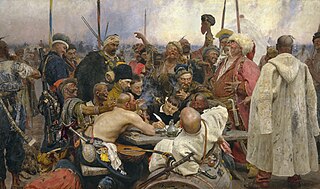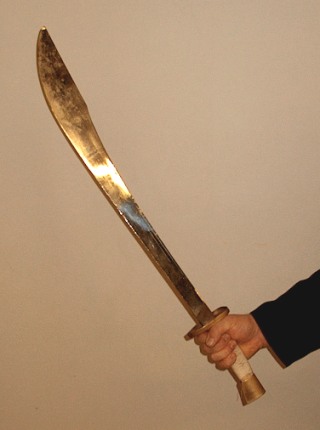
A polearm or pole weapon is a close combat weapon in which the main fighting part of the weapon is fitted to the end of a long shaft,typically of wood,extending the user's effective range and striking power. Polearms are predominantly melee weapons,with a subclass of spear-like designs fit for thrusting and/or throwing. Because many polearms were adapted from agricultural implements or other fairly abundant tools,and contained relatively little metal,they were cheap to make and readily available. When belligerents in warfare had a poorer class who could not pay for dedicated military weapons,they would often appropriate tools as cheap weapons. The cost of training was comparatively low,since these conscripted farmers had spent most of their lives using these "weapons" in the fields. This made polearms the favoured weapon of peasant levies and peasant rebellions the world over.
A sword is an edged,bladed weapon intended for manual cutting or thrusting. Its blade,longer than a knife or dagger,is attached to a hilt and can be straight or curved. A thrusting sword tends to have a straighter blade with a pointed tip. A slashing sword is more likely to be curved and to have a sharpened cutting edge on one or both sides of the blade. Many swords are designed for both thrusting and slashing. The precise definition of a sword varies by historical epoch and geographic region.
A tachi is a type of sabre-like traditionally made Japanese sword (nihonto) worn by the samurai class of feudal Japan. Tachi and uchigatana generally differ in length,degree of curvature,and how they were worn when sheathed,the latter depending on the location of the mei (銘),or signature,on the tang. The tachi style of swords preceded the development of the katana,which was not mentioned by name until near the end of the twelfth century. Tachi were the mainstream Japanese swords of the Kotōperiod between 900 and 1596. Even after the Muromachi period (1336–1573),when katana became the mainstream,tachi were often worn by high-ranking samurai.
A sabre or (American English)saber is a type of backsword with a curved blade associated with the light cavalry of the early modern and Napoleonic periods. Originally associated with Central European cavalry such as the hussars,the sabre became widespread in Western Europe during the Thirty Years' War. Lighter sabres also became popular with infantry of the early 17th century. In the 19th century,models with less curving blades became common and were also used by heavy cavalry.

The jian is a double-edged straight sword used during the last 2,500 years in China. The first Chinese sources that mention the jian date to the 7th century BCE,during the Spring and Autumn period;one of the earliest specimens being the Sword of Goujian. Historical one-handed versions have blades varying from 45 to 80 centimeters in length. The weight of an average sword of 70-centimetre (28-inch) blade-length would be in a range of approximately 700 to 900 grams. There are also larger two-handed versions used for training by many styles of Chinese martial arts.

Dao are single-edged Chinese swords,primarily used for slashing and chopping. They can be straight or curved. The most common form is also known as the Chinese sabre,although those with wider blades are sometimes referred to as Chinese broadswords. In China,the dao is considered one of the four traditional weapons,along with the gun,qiang (spear),and the jian,called in this group "The General of Weapons".

The English language terminology used in the classification of swords is imprecise and has varied widely over time. There is no historical dictionary for the universal names,classification,or terminology of swords;a sword was simply a single-edged or double-edged knife.

The zhanmadao was a single-bladed anti-cavalry Chinese sword. It originated during the Han dynasty and was especially common in Song China (960–1279).

A guandao is a type of Chinese polearm that is used in some forms of Chinese martial arts. In Chinese,it is properly called a yanyuedao,the name under which it always appears in texts from the Song to Qing dynasties such as the Wujing Zongyao and Huangchao Liqi Tushi. It is comparable to the Japanese naginata and the European fauchard or glaive and consists of a heavy blade with a spike at the back and sometimes also a notch at the spike's upper base that can catch an opponent's weapon. In addition,there are often irregular serrations that lead the back edge of the blade to the spike. The blade is mounted atop a 1.5 to 1.8 m long wooden or metal pole and a pointed metal counterweight used to balance the heavy blade and for striking on the opposite end.

A kilij is a type of one-handed,single-edged and curved scimitar used by the Seljuk Empire,Timurid Empire,Mamluk Empire,Ottoman Empire,and other Turkic khanates of Eurasian steppes and Turkestan. These blades developed from earlier Turko-Mongol sabers that were in use in lands controlled or influenced by the Turkic peoples.

The talwar,also spelled talwaar and tulwar,is a type of curved sword or sabre from the Indian subcontinent.

The miaodao (苗刀) is a Chinese two-handed dao or saber,with a narrow blade,long hilt,and an overall length of 1.2 m or longer. The name means "sprout saber",presumably referring to a likeness between the weapon and a newly sprouted plant. An early reference,in Jin Yiming's Single Defense-Saber,makes a connection between the miaodao and the Qing-era wodao,as well as mentioning both single and two-handed versions of the miaodao,suggesting that the name originally described the shape only,without any connotations of size. While the miaodao is a recent weapon,the name has come to be applied to a variety of earlier Chinese long sabers,such as the zhanmadao and changdao. Along with the dadao,miaodao were used by some Chinese troops during the Second Sino-Japanese War.

The shashka or shasqua is a kind of North Caucasian sabre;a single-edged,single-handed,and guardless sabre. The comparatively gentle curve of a shashka blade puts the weapon midway between a typically curved sabre and a straight sword,effective for both cutting and thrusting.

Dha is the Burmese word for "knife" and "sword" similar term to daab or darb in Thai language for a single edge sword. The term dha is conventionally used to refer to a wide variety of knives and swords used by many people across Southeast Asia,especially present-day Myanmar (Burma),Thailand,Yunnan,Laos,and Cambodia and Northeast India.

The yanlingdao or yanmaodao is a type of dao used as a standard military weapon during the Ming dynasty and middle Qing dynasty (1368–1800). The blade is straight until the curve begins around the center of percussion along the last 1/4 or so of the blade approaching the tip. The center of percussion is the point on the blade with the least vibration on hard contact,the spot on the blade that transmits the most power to the target in a hard chop. This allows for thrusting attacks and overall handling similar to that of the jian,while still preserving much of the dao's strengths in cutting and slashing. This type of sword seems to have lost its popularity with military and martial arts practitioners alike by the end of the 18th century,being eclipsed by the more curved liuyedao in the military,and the more broad Oxtail Dao in civilian and martial art settings.
Historically,Chinese swords are classified into two types,the jian and the dao. A Jian is a straight,double-edged sword mainly used for stabbing,and has been commonly translated into the English language as a longsword;while a dao is a single-edged sword mainly used for cutting,and has been translated as a saber or a "knife".

The piandao (片刀) is a type of Chinese sabre (dao) used during the late Ming dynasty and through the Qing dynasty. A deeply curved dao meant for slashing and draw-cutting,it bore a strong resemblance to the Persian shamshir. A fairly uncommon weapon,it was generally used by skirmishers in conjunction with a shield.

The niuweidao was a type of Chinese saber (dao) of the late Qing dynasty period. A heavy bladed weapon with a characteristic flaring tip,it is the archetypal "Chinese broadsword" of kung fu movies today. It was first recorded in the early 19th century and only as a civilian weapon:there is no record of it being issued to Imperial troops,and it does not appear in any listing of official weaponry. Its appearance in movies and modern literature is thus often anachronistic.

The dadao was a type of Chinese saber (dao) of the late Qing dynasty which remained in use as a civilian and military sword through the end of World War 2. The term refers to a whole family of swords,which can vary in blade,guard,and grip configurations. Common elements include a grip long enough to accommodate 2 hands,but with a relatively short and wide blade. Ring pommels are very common,but not exclusively used at the end of the grip. Blade profiles often flare towards the foible and may have a clipped tip.

The Turco-Mongol sabre,alternatively known as the Eurasian sabre or nomadic sabre,was a type of sword used by a variety of nomadic peoples of the Eurasian steppes,including Turkic and Mongolic groups,primarily between the 8th and 14th centuries. One of the earliest recorded sabres of this type was recovered from an Avar grave in Romania dating to the mid-7th century.


















